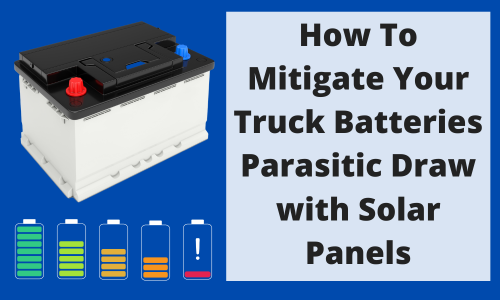How To Mitigate Your Truck Batteries Parasitic Draw with Solar Panels

You walk into work on a sunny Monday morning, sit at your computer, dispatch routes to your fleet of drivers, and sip on a fresh cup of coffee.
You sit back to read the latest industry periodical when your phone rings. One driver after another complains that their truck won’t start. The dreaded “click, click, click” of the engine unable to turn over greeting your drivers, causing frustration and delays.
You knew that parasitic draw might be an issue for your fleet but didn’t anticipate this widespread disruption.
Today’s post dives into what parasitic draw is, why it matters, how to calculate the power your batteries are losing, and ultimately, why solar is an ideal solution to fix this problem.
Take this blog post with you!
What is a Parasitic Draw?
Parasitic draw is when a small amount of energy seeps away from a battery when it isn’t in use, like a parasite feeding on its host. This may be why you have a dead battery if you haven't used your vehicle for an extended period.
Why does parasitic draw matter?
While at first blush, these small amounts of energy might not pose a significant threat to vehicle readiness, over a long enough time, they can prove disastrous for fleet efficiency and costly to your bottom line.
Parasitic draw, if left unmanaged, can reduce fleet readiness for starting batteries that sit too long, resulting in vehicles that can’t turn over and start when needed. Importantly, this goes far beyond just the starting battery.
Suppose you have a telematics system tied to an auxiliary battery or hardwired into the starting battery. In that case, it can also suck down power, reducing the ability to keep track of your vehicles or empty the starting battery even faster. Even a short to ground buried in a wire loom can be a parasitic draw that negatively impacts your vehicle.
Parasitic draw empties batteries over time, resulting in increased cost, decreased efficiency, and unpredictable periods of downtime.
Additionally, it can prohibit the addition of essential and innovative features for fleet management (telematics solutions, etc.)
How do you determine the amount of parasitic draw on your truck?
Knowing how much power you are losing is vital to mitigate parasitic draw.
You can check your parasitic draw on your truck with a DC loop multimeter while the truck is off. If this is a steady state value for the parasitic draw, you can determine if you will be safe or have to get a jump start. Suppose you have variability in the parasitic draw due to telematics or other functions. In this case, you’ll want to log data over a day or two to get an average parasitic current draw.
Is there an acceptable amount of parasitic draw?
Now that you know the amount of draw on our truck, your next thought may be to isolate the exact location of the draw and shore it up.
This is easier said than done.
Often, the culprit could be a worn wire that is nearly impossible to isolate amongst the dozens of other cables in your truck’s system. To mitigate this parasitic draw, the simplest and least stressful solution is to pair that draw with the appropriate solar panel to cancel it out. Before you can do that, let’s see what level of mitigation is necessary by working through an example.
We chose a standard starting battery bank in commercial Class 8 trucks for this example.
That includes four Group 31 batteries in parallel, resulting in a 12V / 400Ah battery bank or 4800Wh. These are lead-acid batteries, which figure into the self-discharge part of the calculation – lead-acid batteries self-discharge at eight percent per month.
How can solar solve the parasitic draw problem?
The table below estimates the acceptable parasitic current draw you could accommodate and still be able to start your truck within the specified interval with and without a solar solution.
This table assumes the battery bank must have 25 percent of full power to start the engine.
Take note of the wide range between planned starting events: 17 months, six months, 30 days, seven days, and two days.
Acceptable Parasitic Current Drains with and without a Solar Panel The time between starting a truck with a 4800Whr battery bank before the battery dies |
|||||
|
Solar Panel |
17 months |
6 months |
30 days |
7 days |
2 days |
|
No Solar |
0mA |
35mA |
370mA |
1.7A |
6.2A |
|
27W, 12V |
120mA |
155mA |
490mA |
1.8A |
6.3A |
|
50W, 12V |
225mA |
260mA |
590mA |
2.0A |
6.4A |
|
110W, 12V |
470mA |
50 mA |
840mA |
2.2A |
6.7A |
NOTE: We can create a reference table using your specific values to help you make an informed decision.
How can solar panels change the values so dramatically?
Solar panels convert light to energy when the sun is out, helping to, at worst, cancel out your parasitic draw and, at best, continually increase your battery's state of charge.
How to determine the size of the solar panel you need to mitigate your parasitic draw.
Inherently, solar energy is a variable power source. Solar panel output power varies due to clouds, dust, latitude, time of day, time of year, orientation to the sun, and more.
A best practice is to de-rate the panel power by a factor of two or three to accommodate bad sun days for critical applications (starting your truck).
Since our application is trucking, selecting an average across the lower 48 states, 4.5 full sun hours per day, is best.
NREL (National Renewable Energy Laboratories) maps the average annual solar resources available across the United States (see below).
In many cases, a panel as small as 27W will provide enough power to keep your battery full and ready to go. If you have a more complex requirement, please reach out.

What solutions does PowerFilm have to minimize the effect of this draw?
PowerFilm trucking panels feature integrated charge controllers and, if desired, provisional patented integrated tape perimeter for quick installation.
%20(Web).png?width=185&height=295&name=27W%20Semi-Flexible%20Solar%20Panel%20with%20Integrated%20Charge%20Controller%20%26%20Butyl%20Tape%20(Transparent)%20(Web).png)
27W trucking panel prototype
Learn more about our additional trucking solar solutions.
Need something you can’t find off-the-shelf?
We specialize in custom solutions and will build a solution that meets your requirements.
Learn more about our custom capabilities.
Parasitic draw empties batteries over time, resulting in increased cost, decreased efficiency, and unpredictable periods of downtime, but with solar, it doesn’t have to.
Ask yourself, “How much shop time/money can I spend looking for a parasitic draw?”
Is a solar panel a better, less expensive solution?
While adding solar requires an investment, it will pay dividends for your fleet in the future.
Contact us, and let’s create a custom solar solution.
Take this blog post with you!